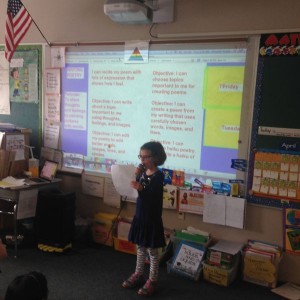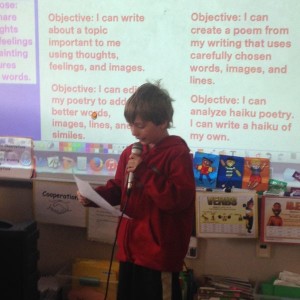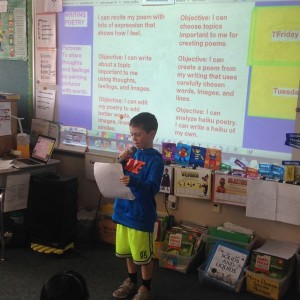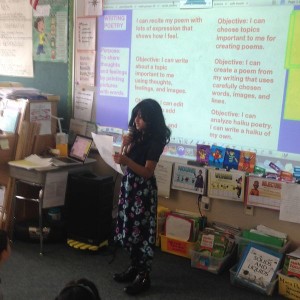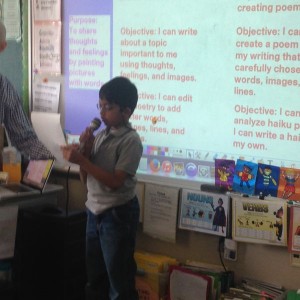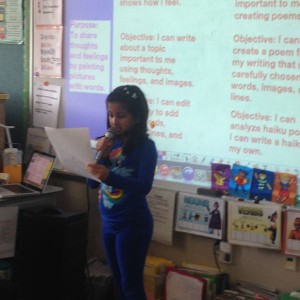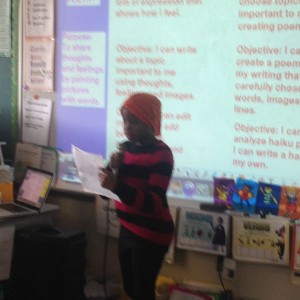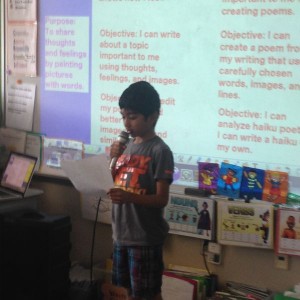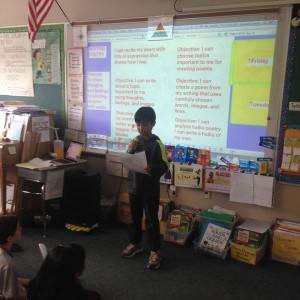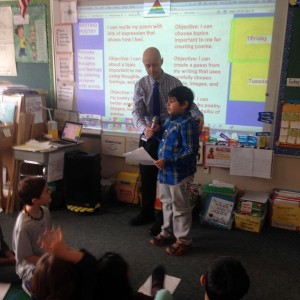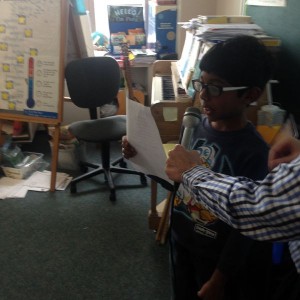Posted by kavery508 | Posted in Uncategorized | Posted on April 6, 2015
 Less than 10 weeks to go! We’ve come so far and grown so much. The race to the finish begins!
Less than 10 weeks to go! We’ve come so far and grown so much. The race to the finish begins!
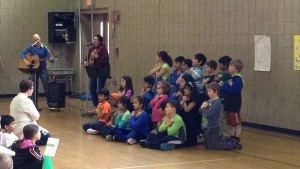 At Friday’s School Meeting, we learned about the diversity of races, languages, and countries represented at Floral St. We were proud to represent our community as we lead Grades 1 & 2 in song and in sign language.
At Friday’s School Meeting, we learned about the diversity of races, languages, and countries represented at Floral St. We were proud to represent our community as we lead Grades 1 & 2 in song and in sign language.
 Now that we’ve learned so much, our CAFE focus involves ‘putting it all together’. As we read narratives and nonfiction text together, in small groups, and individually, we are applying word skills learned in combination with comprehension strategies taught: Activating Schema and Making Connections, Predicting, Asking Questions and Reading to Find Answers, Inferring, Visualizing, Determining Important Parts of Text and Inferring the Messages, and Summarizing. Students should be able to do this at any reading level now. Try asking questions about any of the above strategies during reading homework!
Now that we’ve learned so much, our CAFE focus involves ‘putting it all together’. As we read narratives and nonfiction text together, in small groups, and individually, we are applying word skills learned in combination with comprehension strategies taught: Activating Schema and Making Connections, Predicting, Asking Questions and Reading to Find Answers, Inferring, Visualizing, Determining Important Parts of Text and Inferring the Messages, and Summarizing. Students should be able to do this at any reading level now. Try asking questions about any of the above strategies during reading homework!
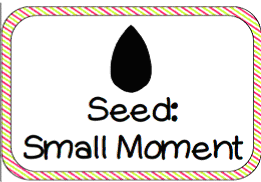 We will spend the next three weeks revisiting Narrative Writing. Students should be able now to choose topics from their lives to write about; select the “seed” (best small moment to stretch out over several paragraphs; and write with detail and description to put the reader in the picture. This week we will learn how to add Red Flags to our writing. These are transitional phrases that keep the reader’s interest: Without warning; Suddenly; A second later; Finally; etc. We will also learn what makes a good ending. Initially, many kids want to end their stories with “Then I went home and went to bed,” thinking the end of a day should equal the end of a story. Instead, students should end by reflecting on what was written using a combination of feelings, memories, and/or hopes/decisions for the future: I’ll never forget that trip to Old Sturbridge Village and how funny it seemed when I fell into the pond. I still laugh thinking about it. Next time, I’ll stay on the path for sure!
We will spend the next three weeks revisiting Narrative Writing. Students should be able now to choose topics from their lives to write about; select the “seed” (best small moment to stretch out over several paragraphs; and write with detail and description to put the reader in the picture. This week we will learn how to add Red Flags to our writing. These are transitional phrases that keep the reader’s interest: Without warning; Suddenly; A second later; Finally; etc. We will also learn what makes a good ending. Initially, many kids want to end their stories with “Then I went home and went to bed,” thinking the end of a day should equal the end of a story. Instead, students should end by reflecting on what was written using a combination of feelings, memories, and/or hopes/decisions for the future: I’ll never forget that trip to Old Sturbridge Village and how funny it seemed when I fell into the pond. I still laugh thinking about it. Next time, I’ll stay on the path for sure!
 Our poetry lessons have yielded a fruitful bounty (how’s that for a metaphor?)! Students made great progress writing about a topic important to them with images, feelings, careful word choice, and an understanding of lines. Below are a few pictures of students reciting their poetry after working on expression and volume. I have published all of the students’ poems in a bound collection that I will send home Monday. Be on the lookout! Here are 2 selections. Notice their amazing metaphors, imagery, and careful word choice:
Our poetry lessons have yielded a fruitful bounty (how’s that for a metaphor?)! Students made great progress writing about a topic important to them with images, feelings, careful word choice, and an understanding of lines. Below are a few pictures of students reciting their poetry after working on expression and volume. I have published all of the students’ poems in a bound collection that I will send home Monday. Be on the lookout! Here are 2 selections. Notice their amazing metaphors, imagery, and careful word choice:
My Baby Brother
Tiny nose
Two small sparkling eyes
His cute little face
as soft as a cloud
Puny lips red as strawberries
Handsome thin hands curl up inside
Miniature toes on smooth feet
His hands grab my heart.
by Luana DeMoura
Cheetahs
Their spots like dark moons
their legs dash like lightning
their paws and claws scratching
the ground.
Their fur is a blanket
of African grass.
Exhausted, walking to their lair.
The orange hot sun rising
on the hot savannah.
by Arjun Singh
 This week’s math focuses on relating difference to subtraction, and learning mental math strategies to subtract. Since subtraction is the inverse operation of addition, we make a connection to last week’s strategies. To find the difference when only the ones place changes, we simply subtract and don’t mess with the tens and hundreds: 267 -5 is the same as 7 -5–just remember to put back the 260. To subtract in your head when only the tens place changes, just count back by tens: 267 – 50 should sound like 257, 247, 237, 227, 217. And the same applies when only the 100s place changes: 267 – 100 = 167.
This week’s math focuses on relating difference to subtraction, and learning mental math strategies to subtract. Since subtraction is the inverse operation of addition, we make a connection to last week’s strategies. To find the difference when only the ones place changes, we simply subtract and don’t mess with the tens and hundreds: 267 -5 is the same as 7 -5–just remember to put back the 260. To subtract in your head when only the tens place changes, just count back by tens: 267 – 50 should sound like 257, 247, 237, 227, 217. And the same applies when only the 100s place changes: 267 – 100 = 167.
To quickly subtract 7, 8, or 9 in our heads, we can subtract 10 instead and count up 3, 2, or 1. For example: 432 – 7 is the same as 432 – 10 (422) + 3 (425) since -10 +3 = 7. And 432 – 8 is the same as 432 – 10 (422) + 2 (424), and 432 – 9 is the same as 432 – 10 + 1. There will be illustrated examples in the math homework resources folder this week to keep these straight. These tricks can really work, and show a real fluency with numbers. It is important, therefore, that students try them out repeatedly if they are ever to own them or use them when it suits them to do so.
Hope you can make it to Literacy Night this Friday, 6-9 PM. There are many great activities planned to help us celebrate as a community of readers!

